Reading Product Labels for a Gluten-free Diet in Canada
Share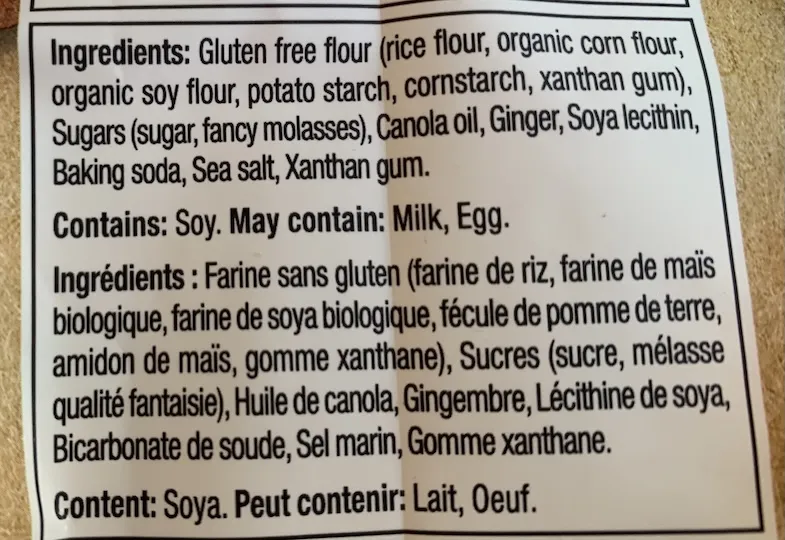
Ingredients list label reading is very important for those of us with celiac disease. When I was first diagnosed, I found it very overwhelming. I hadn't really paid attention to products ingredients lists before. It was so time consuming to read each label, and then try to decide if it was safe or not for me to consume.
Fast forward a decade and it is much easier. The Canadian Celiac Association worked very hard with the Federal Government of Canada to implement allergy/gluten labelling laws for food products sold in Canada.
I always try to remember to read the labels and ingredients lists, even on certified gluten-free food. I want it to remain a habit - something I do without thinking. But, I have made the occasional mistake. A product that was safe, changed their ingredients. I bought it without reading the label, only to discover at home that "malt vinegar (barley)" was now on the label! Lesson learned! Always read labels, even on products you are comfortable with.
Now this blog is focused on Canada and Canadian labelling laws because this is where I live. Other countries have different labelling laws. This includes our neighbour, the USA.
- What does "Gluten-Free" on products mean in Canada?
- What must be listed on a food label in Canada?
- Do products need to be certified gluten-free to be safe?
- What does BROW stand for?
- "Contains" and "May Contains" Statements on Ingredients Lists
- Questions to ask yourself when looking at product labels
- Are gluten reading apps useful?
- Glucose syrup? Safe?
- Corn based products. When are they safe for a celiac? What about Cornstarch?
- What does BROW stand for?
I highly recommend reading the Canadian Celiac Associations website. Join your local group. Take their online label reading and shopping courses. They are a great resource for both the newly diagnosed celiac, and for those of us that were diagnosed ages ago. Things are always changing regarding gluten and celiac disease and checking in with the Canadian Celiac Association is a fantastic way to keep up-to-date. Here is a link to the Canadian Celiac Association's page regarding label reading. It is very useful.
What does "Gluten-Free" on products mean in Canada?
Canada regulates the use of the term "gluten-free". A "gluten-free" claim on a product means that it doesn't contain any added gluten (barley, rye, oats, wheat, triticale), and that it has been tested, and has less than 20 ppm (parts per million) of gluten from unavoidable cross contamination.
But, you may be thinking, which agency does the regulation? There are two agencies involved: Health Canada, and the Canadian Food Inspection Agency (CFIA). The CFIA is responsible for ensuring the compliance and enforcement of gluten-free claims, by following Health Canada and the Food and Drugs Act and the Food and Drug Regulations for guidance.
The Canadian Government uses the Codex Alimentarius Standard for Foods for Special Dietary Use for Persons Intolerant to Gluten ( Codex Stan 118-1979) which is recognized internationally and states that the gluten content of foods labelled gluten free shall not exceed 20 ppm.
For more detailed information on Canada's food product labelling laws check out these websites:
- "Gluten-Free" Claims in the Marketplace Government of Canada, Agriculture and Agri-Food Canada, April 2014 publication
- Health Canada's Position on Gluten-Free Claims Government of Canada, June 2012
- Canadian Food Inspection Agency, Compliance and enforcement of gluten-free claims
In Canada, "certified gluten-free" means that the product has been tested by a third-party and has a minimum gluten threshold set by that third-party. One such Canadian third-party certification is The Gluten-Free Certification Program (GFCP). They use the less than 20 ppm threshold. You can see an example of the trademark on the product in the photo below.
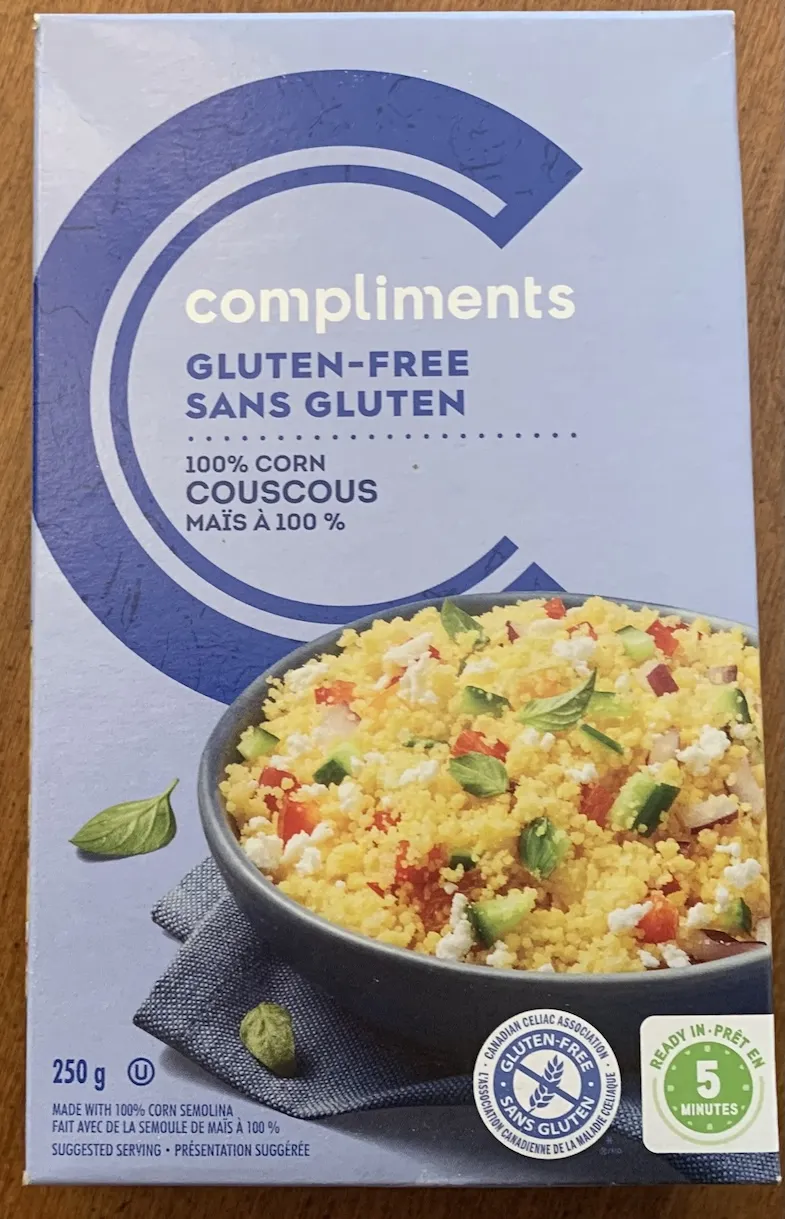
This is just one example of a certified gluten-free trademark. There are many others.
"Gluten-free" and "Certified Gluten-free" on a label do not mean that they contain zero gluten. It means that the minuscule amount that may be in the product won't harm a celiac, but for those with wheat allergies the product is unsafe as they would need it to contain zero gluten.
What must be listed on a food label in Canada?
Priority allergens
- Crustaceans and molluscs
- Eggs
- Fish
- Milk
- Mustard
- Peanuts
- Sesame seeds
- Soy
- Sulphites
- Tree Nuts: almonds, Brazil nuts, cashews, hazelnuts, macadamia nuts, pecans, pine nuts, pistachios or walnuts
- Wheat and triticale
Gluten sources
- Barley
- Oats (due to possible cross-contamination) *Gluten-Free or Purity Oats are ok for celiacs*
- Rye
- Triticale
- Wheat
In Canada, the above ingredients must be declared on food labels. They can't be hidden. They must be either in the actual ingredients list or in a "contains" statement right after the ingredients list.
Do products need to be certified gluten-free to be safe?
Short answer is, no they don't. With the disclaimer: No barley, wheat, rye, or oats and as long as the product isn't high risk, such as flours, cereals, legumes, pasta, hemp seeds, flax seeds, and baked goods. The high risk items are from possible cross contamination. You need to read the label and if there are no gluten ingredients, the product is safe for celiacs. In Canada gluten ingredients can't be hidden, and they must be in plain english. You can trust the ingredients list in Canada.
The Canadian Celiac Association has a very useful Gluten-Free Defined pdf article. I recommend taking a look at it.
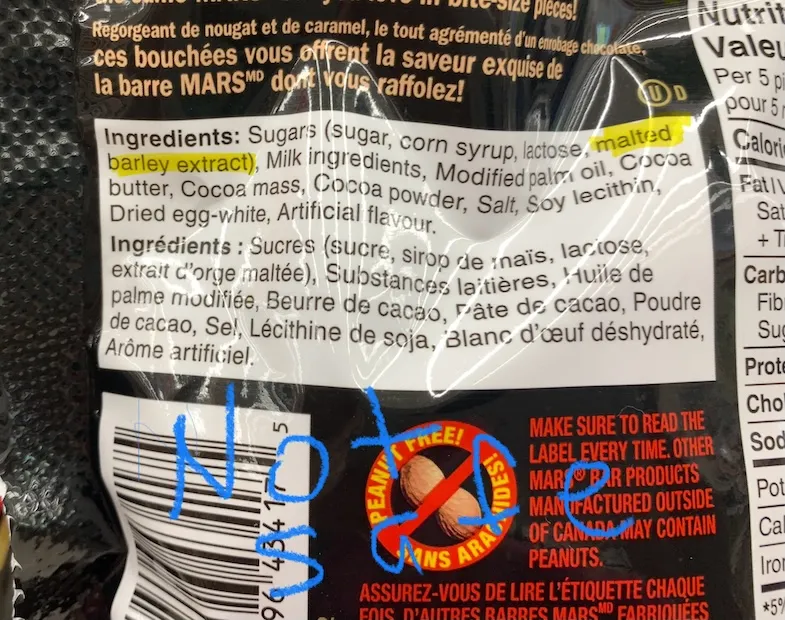
If a product does contain gluten - then it either has to be listed in the ingredients label list, like on the Mars Bar packaging above (Mars Bars are not safe for celiac's to consume), or in a 'contains statement' like on the Tim Horton's Butternut Soup product in the photo below.
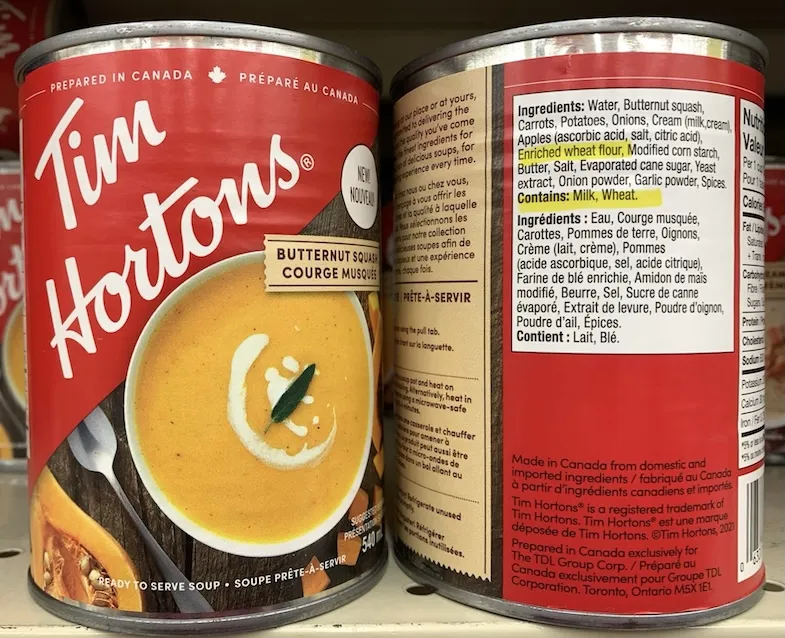
What does BROW stand for?
In Canada, gluten sources can't be hidden on products ingredients list. They must be declared in plain language. The acronyom BROW is very helpful. It stands for Barley, Rye, regular Oats and Wheat. If any of these ingredients are on the label it is not safe for a celiac to eat.
Other words that mean wheat to look out for: triticale (a hybrid grain created by crossing wheat and rye), kamut, spelt (dinkel, farro), atta, bulgur, couscous, durum, einkorn, emmer, farina, fu, graham, seitan, semolina. But, none of these words can be on a list without the word "wheat" also on the label. Wheat cannot be hidden in Canada. (Referenced from the Government of Canada Allergens and gluten sources labelling website)
Recently, there have been some non-wheat based couscous in stores, that is labelled gluten-free. Such products are safe for celiacs.
"Contains" and "May Contains" Statements on Ingredients Lists
In Canada, priority allergens, gluten sources, and sulphites must be clearly stated in ingredients lists and/or immediately after the list of ingredients in a "contains statement". If any of the BROW ingredients are on there it is not safe for a celiac to consume.
"May Contains" statements, sometimes called "precautionary statements" are voluntary in Canada and are not regulated. If such a statement is on a product that is not certified gluten-free then it is unsafe for celiac's to consume. If it is on a product that is certified gluten-free, like the Skippy's Gluten-Free Caramel Corn in the photo below, then it is safe for celiac's to consume. It is there for someone who has a wheat allergy. The amount of wheat would be less than 20 ppm in Canada.
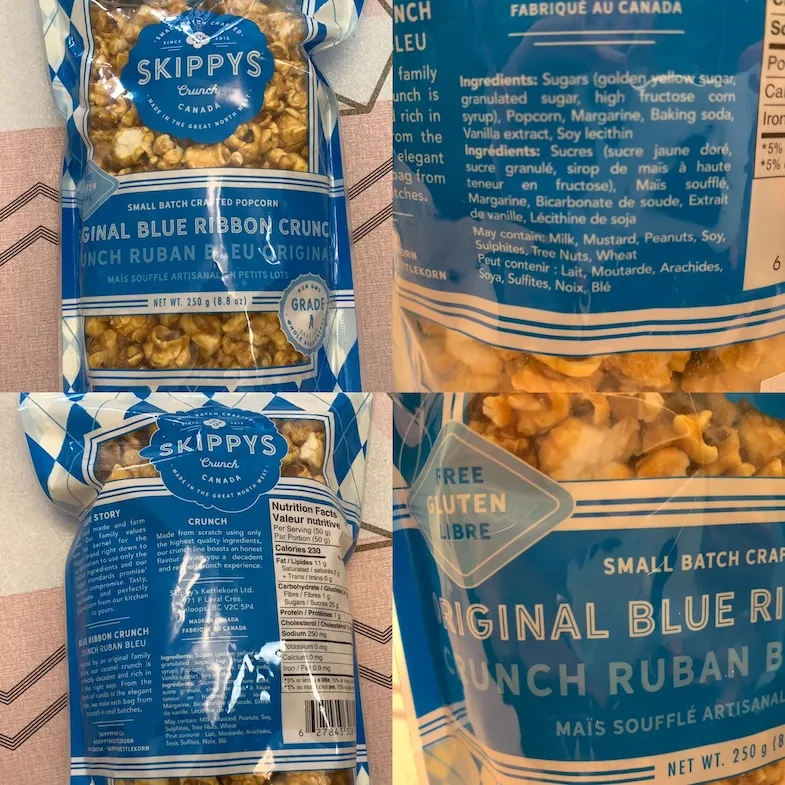
Questions to ask yourself when looking at product labels
Now when reading labels for gluten in Canada start with asking yourself these questions.
- Is it a high risk product? Grains, cereal, dried lentils or beans?
- Do you see any of the ingredients from the BROW acronym? Barley, rye, oats, wheat (triticale)?
- Is there a "contains" statement for any of the BROW ingredients?
- Are any of the first two ingredients corn flour or corn meal or ground corn?
If you answer no to all of the above then the product is safe for celiac's to consume.
"Yeast" and "yeast extract" sometimes causes concern, but you don't need to worry in Canada. As long as there are not BROW ingredients listed on the ingredients list or in a contains statement, the product is safe for celiac's to consume. In Canada you can trust the label.
The Tim Horton's Cream of Broccoli soup ingredients lists shows "yeast extract", but it is safe because there are no BROW ingredients in brackets behind it or in the contains statement. If there is a contains statement then all priority allergens and gluten must be included. Companies can't pick and choose.
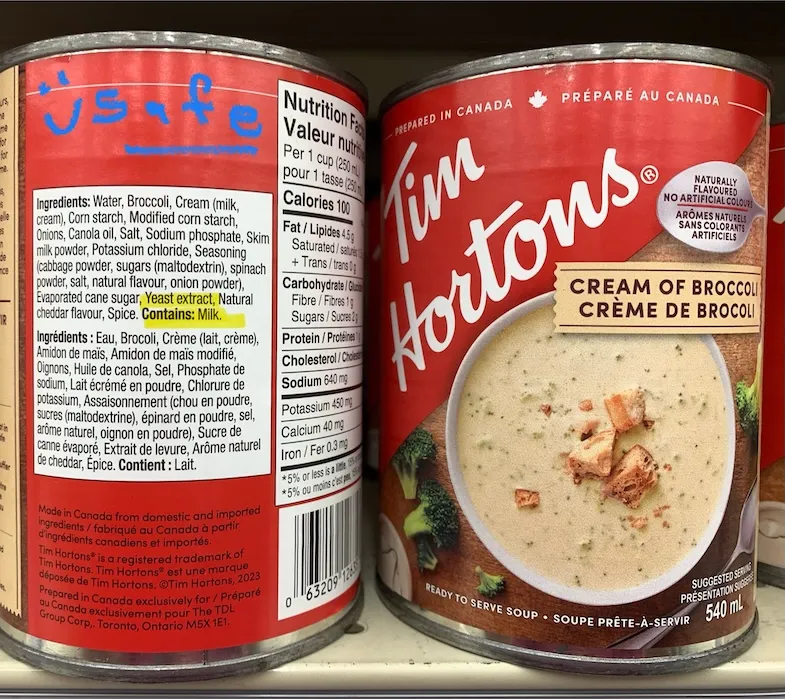
Are gluten reading apps useful?
There are apps that state they help identify gluten in products. They are made for the US market. Don't use them in Canada. The apps can be unreliable as most are using USA gluten labelling laws which are different from Canadian laws. In Canada you can trust the label.
Glucose syrup? Safe?
Glucose syrup is safe for celiacs to consume even if it is made from wheat or barley. It is safe due to it's extensive processing at the factory which remove the gluten protein.
Canada Celiac Association (CCA) has some great courses, such as the gluten free 101 program.
Corn based products. When are they safe for a celiac? What about Cornstarch?
Corn products. At the time of writing this blog, the Canadian Celiac Association states that if corn flour and/or corn meal is listed as a first or second ingredient in the ingredients list, they are not considered safe for celiac's unless they have a gluten-free claim. This is due to possible cross-contamination at the factory. Other corn products such as corn starch are safe without a gluten-free claim. If the product is not high risk, like cereal and is not certified gluten-free, but cornmeal or corn flour is located further down the ingredient list, it is my understanding that it is considered to be safe for celiac's to consume.
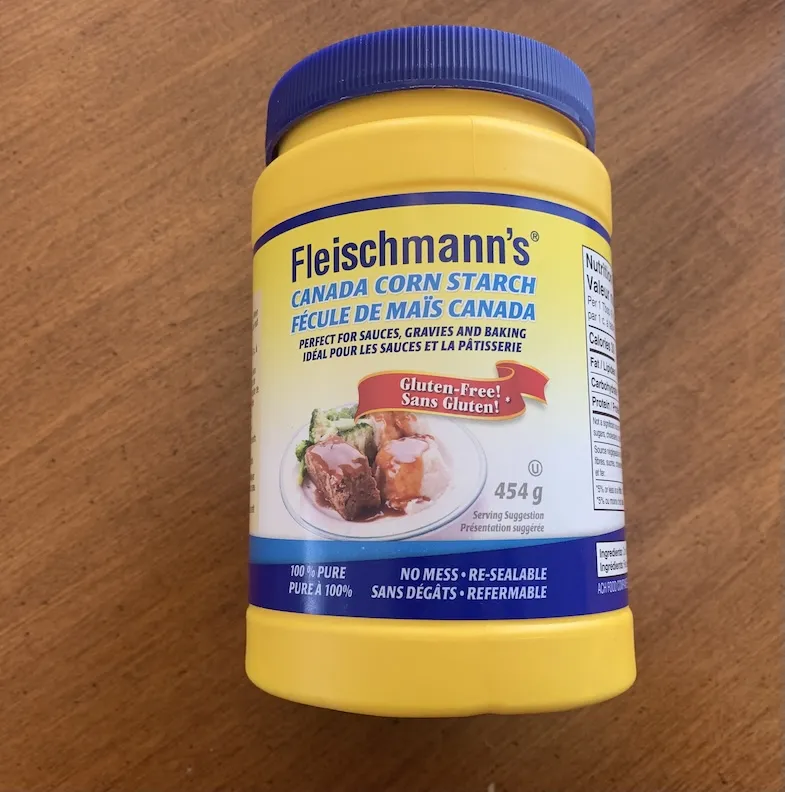
Cornstarch is highly processed and therefore considered safe for celiac's. It doesn't need a gluten-free claim. But, do still read the ingredients lists as I hear that some cornstarch's have a "may contain" gluten claim. I use Fleischmann's corn starch. You can see the ingredient's list below.
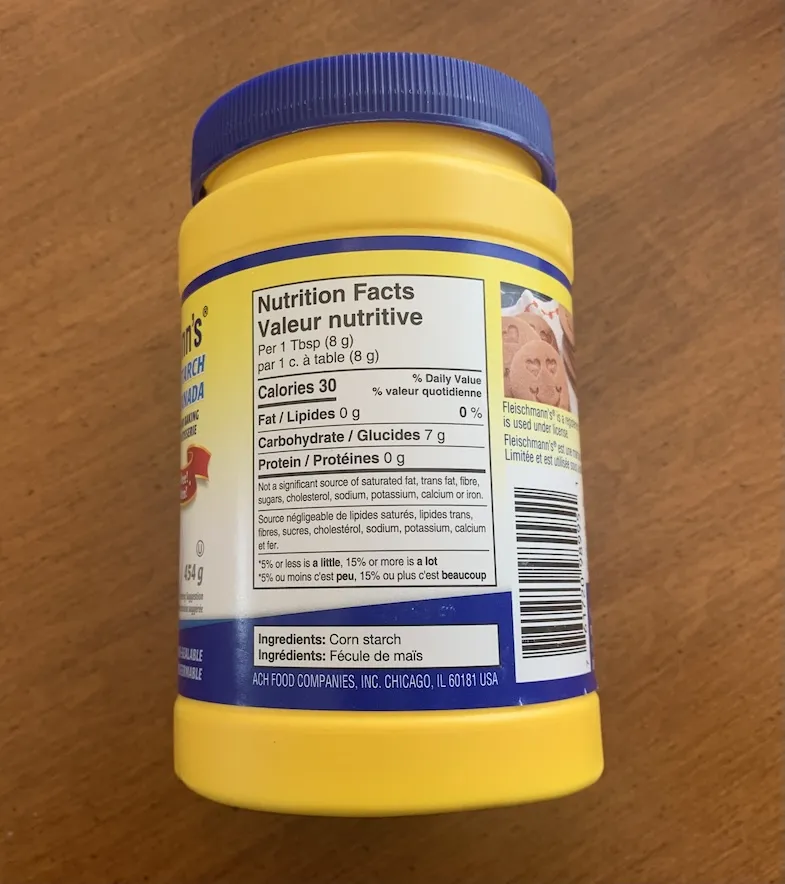
For more information on corn products in Canada and whether they are safe or not check out the Canadian Celiac's Association "Corn Statement".
Summary
In summary, celiac's in Canada can trust a food product's ingredients list. If it is not labelled gluten-free and is not a high risk product like flours and cereals, and has no BROW + T (barley, rye, regular oats, wheat and triticale) listed then it is safe for a celiac to consume. If it is labelled gluten-free or certified gluten-free and has a "may contains" statement showing wheat then it is still safe for celiacs to consume, but not safe for someone with a wheat allergy.
If you are newly diagnosed then do check out the Canadian Celiac Association's website. They are a great source of educational information.
This blog is about Canada and Canadian labelling laws for gluten. The USA has different labelling laws as do other countries. When travelling do your research.
All food products sold in Canada whether manufactured here or abroad must legally follow our labelling laws.
I hope this was useful. The information provided is up-to-date when this blog was posted and is my interpretation of the laws. Please see the disclaimer below.
Note: These are my personal experiences and opinions. Always seek out a medical opinion for medical concerns. Not sponsored. If sponsored I will always say so at the top of the post.